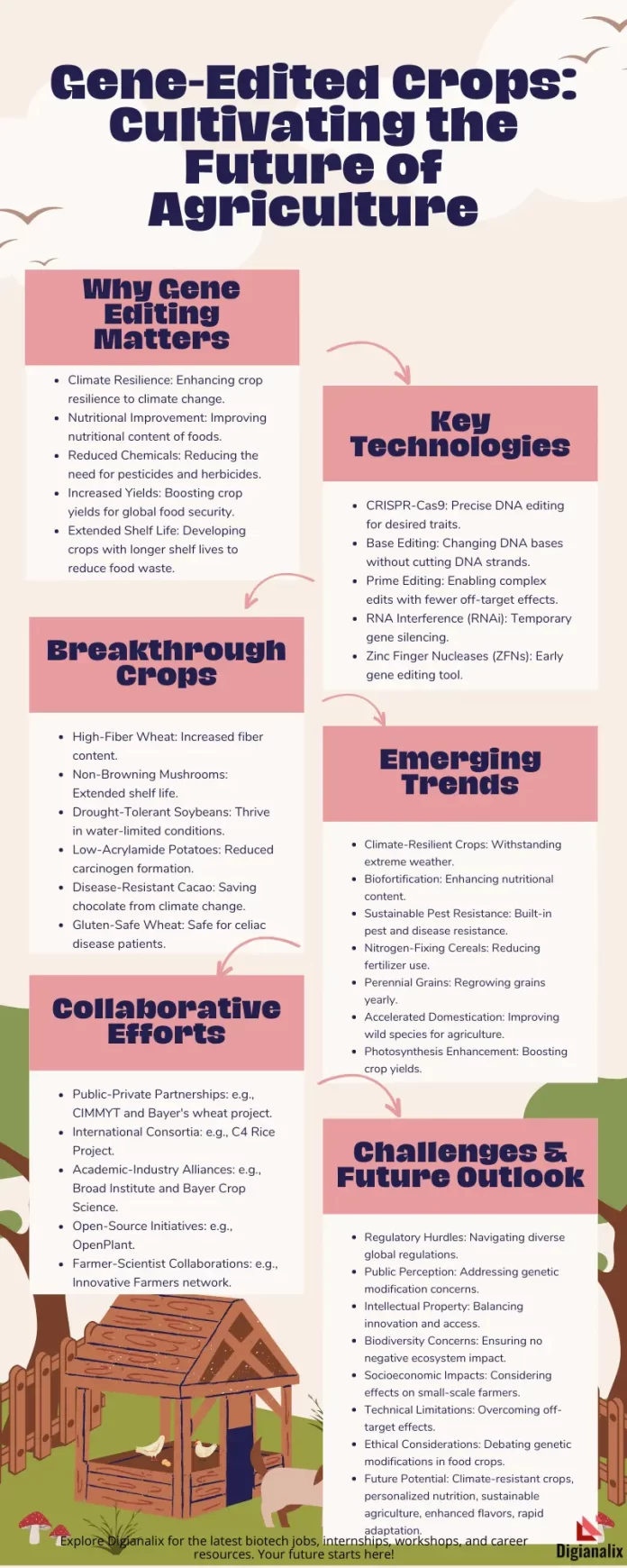Hey biotech enthusiasts and ag-tech innovators! 👋 Remember when we explored the revolutionary potential of CRISPR technology? (If you missed it, catch up on our deep dive into CRISPR and Beyond: The Future of Gene Editing. We’ve also seen how CRISPR is transforming medicine (refresh your memory with our exploration of CRISPR in Medicine: Revolutionizing Disease Treatment. Now, let’s turn our attention to the fields – quite literally – and discover how gene editing is reshaping the future of agriculture!
🌱 Why Gene Editing Matters in Agriculture Gene-edited crops are revolutionizing farming by:
- Enhancing crop resilience to climate change
- Improving the nutritional content of foods
- Reducing the need for pesticides and herbicides
- Increasing crop yields to address global food security
- Developing crops with longer shelf lives to reduce food waste
Let’s dig into the groundbreaking developments of 2024!
🧬 Key Gene Editing Technologies in Agriculture
CRISPR-Cas9: The Game Changer
Technique: Precise DNA editing for desired traits Example: Corteva Agriscience’s waxy corn for improved starch production
Base Editing: Fine-Tuning Genes
Technique: Changing individual DNA bases without cutting the DNA strand Example: Yield10 Bioscience’s camelina with enhanced oil content
Prime Editing: Versatile Gene Modification
Technique: Enabling more complex edits with fewer off-target effects Example: Inari Agriculture’s water-efficient corn varieties
RNA Interference (RNAi): Temporary Gene Silencing
Technique: Suppressing specific genes without altering DNA Example: Bayer’s SmartStax PRO corn for rootworm resistance
Zinc Finger Nucleases (ZFNs): Pioneering Precision
Technique: Early gene editing tool still used for specific applications Example: Sangamo Therapeutics’ disease-resistant wine grapes
🌟 Breakthrough Gene-Edited Crops
- High-Fiber Wheat: Calyxt’s wheat with increased fiber content for better nutrition
- Non-Browning Mushrooms: Penn State’s CRISPR-edited mushrooms with extended shelf life
- Drought-Tolerant Soybeans: Yield10 Bioscience’s soybeans that thrive in water-limited conditions
- Low-Acrylamide Potatoes: Simplot’s Innate potatoes with reduced carcinogen formation when fried
- Disease-Resistant Cacao: Innovative Genomics Institute’s efforts to save chocolate from climate change
- Gluten-Safe Wheat: Work underway to develop wheat safe for celiac disease patients
💡 Emerging Trends in Agricultural Gene Editing
Climate-Resilient Crops
Focus: Developing crops that withstand extreme weather conditions Potential: Ensuring food security in the face of climate change
Biofortification
Focus: Enhancing nutritional content of staple crops Opportunity: Addressing global malnutrition through everyday foods
Sustainable Pest Resistance
Focus: Creating crops with built-in pest and disease resistance Frontier: Reducing chemical pesticide use in agriculture
Nitrogen-Fixing Cereals
Focus: Engineering non-legume crops to fix their own nitrogen Potential: Reducing fertilizer use and environmental impact
Perennial Grain Crops
Focus: Developing grains that regrow year after year Application: Reducing soil erosion and increasing carbon sequestration
Accelerated Domestication
Focus: Rapidly improving traits of wild species for agriculture Opportunity: Diversifying our food sources and crop resilience
Photosynthesis Enhancement
Focus: Improving the efficiency of plant energy production Frontier: Significantly boosting crop yields and food production
🤝 Collaborations Driving Innovation
- Public-Private Partnerships: e.g., CIMMYT and Bayer’s collaboration on drought-tolerant wheat
- International Research Consortia: e.g., C4 Rice Project for improving rice photosynthesis
- Academic-Industry Alliances: e.g., Broad Institute and Bayer Crop Science
- Open-Source Initiatives: e.g., OpenPlant for sharing genetic tools and resources
- Farmer-Scientist Collaborations: e.g., Innovative Farmers network in the UK
🚦 Challenges in Gene-Edited Agriculture
- Regulatory Hurdles: Navigating diverse global regulations on gene-edited crops
- Public Perception: Addressing concerns and misconceptions about genetic modification
- Intellectual Property Issues: Balancing innovation protection with access to technology
- Biodiversity Concerns: Ensuring gene-edited crops don’t negatively impact ecosystems
- Socioeconomic Impacts: Considering the effects on small-scale farmers and global agriculture
- Technical Limitations: Overcoming off-target effects and improving edit precision
- Ethical Considerations: Debating the extent of genetic modifications in food crops
🔮 Future Outlook The future of gene-edited crops is incredibly promising, with potential for:
- Climate-change-resistant staple crops ensuring global food security
- Personalized nutrition through crops tailored to specific health needs
- Sustainable agriculture with minimal environmental impact
- Novel foods with enhanced flavors, textures, and nutritional profiles
- Rapid adaptation of crops to new environments and challenges
What gene-edited crop innovations excite you the most? Are you involved in agricultural biotechnology research? Share your thoughts and experiences in the comments below!
Stay updated on the latest in gene-edited agriculture by subscribing to our site. Let’s cultivate a future where science and nature work hand in hand for a more sustainable and nourishing world!




